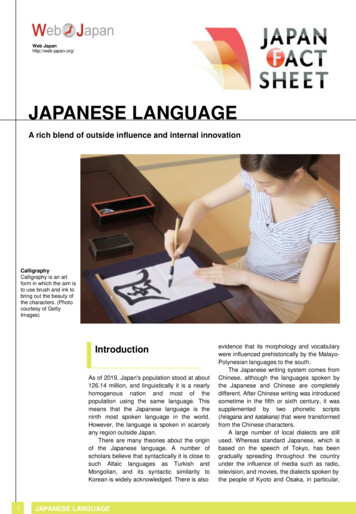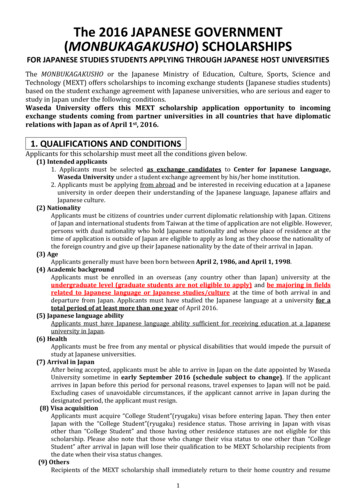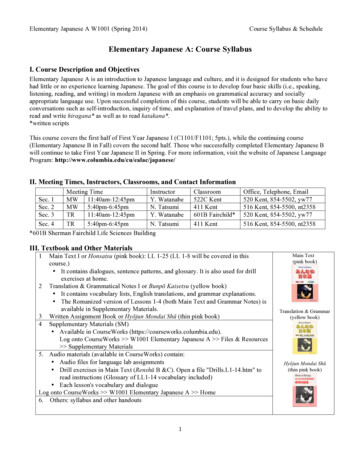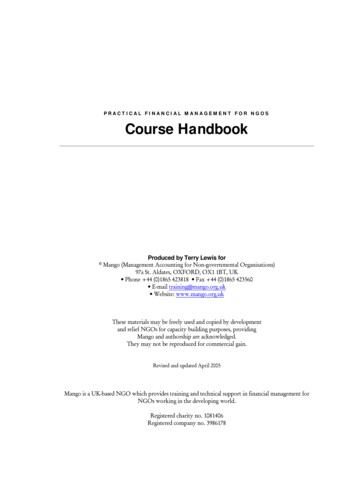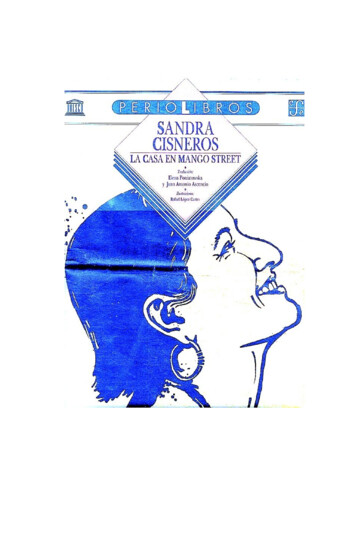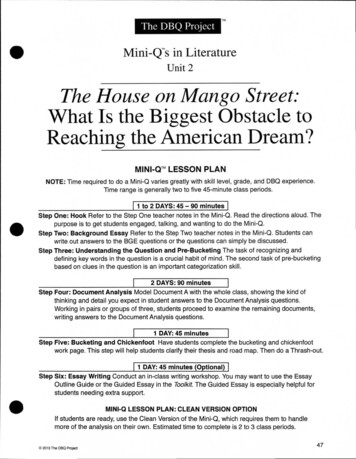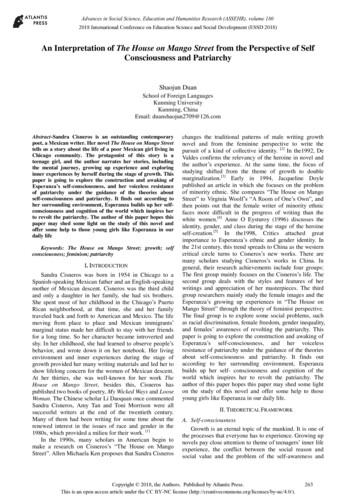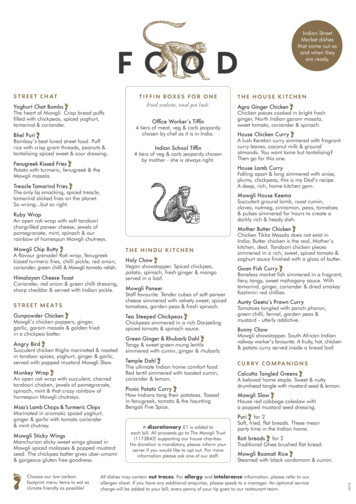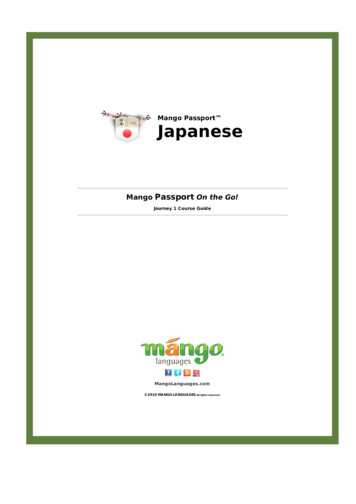
Transcription
Mango Passport JapaneseMango Passport On the Go!Journey 1 Course GuideMangoLanguages.com 2010 MA NGO LA NGUA GES All rights reserved.
Table of ContentsTable of ContentsJourney 1 Chapter 1: Greetings, Gratitude, GoodbyesJourney 1 Chapter 2: Do You Speak English?Journey 1 Chapter 3: What's Your Name?Journey 1 Chapter 4: Where Is the Restroom?Journey 1 Chapter 5: How Much Is It?Journey 1 Chapter 6: At a RestaurantJourney 1 Chapter 7: Money MattersJourney 1 Chapter 8: In Case of EmergencyJourney 1 Chapter 9: What Does It Mean?Journey 1 Chapter 10: Please Speak in JapaneseVocabulary ReviewPhrase ReviewCultural NotesGrammar Notes231118263650637690103116138166179
Mango Passport - JapaneseCHAPTER 1: GREETINGS , GRATITUDE, ことばJourney 1 Chapter 1: Greetings, Gratitude, GoodbyesConversational GoalsExpress GratitudeGreet PeopleMake Small Talk with StrangersSay GoodbyeGrammar GoalsForm Sentences Using the Copula ですForm Yes/No Questions with the Particle かLearn the Basic Sentence StructureLearn to Properly Use the Conversational Particle �いてんきですね。Good afternoon. It's a nice day, isn't it!(konnichiwa. ii tenki desu ne.)ええ。かんこうですか。Yes. Are you sightseeing?(ee. kankoo desu ka.)ええ、そうです。Yes, that's right.(ee, soo desu.)きをつけて!Take care!(ki o �、さようなら。Thank you. Well, goodbye.(arigatoo gozaimas. jaa, angoLanguages.com 2010 MANGO LANGUAGESAll rights reserved.3
Mango Passport - JapaneseGood afternoon.こんにちは。EnglishJapaneseThis course will adopt the conventional "romaji" method to transcribe Japanese words andsentences. The five vowels are spelled like this: あ (a), い (i), う (u), え (e), お (o). Each Japaneseletter is spelled as a combination of a consonant and a vowel as in さ (sa) or ぎ (gi), except for ん (n)which has no vowel. Long vowels are spelled with double vowels as in ああ (aa) or いい (ii). Some1words containing a special sound are spelled out like this: きって (kitte, with double consonant), キャンプ (kyanpu), and とうきょう (tookyoo). The romaji method is simple and useful for beginners tofigure out how to read Japanese. That's why it is often used to transcribe Japanese words in namecards, road and station signs, textbooks, and so on for the convenience of non-native speakers.Please be aware, however, that the romaji method doesn't always reflect some fine points of actualpronunciation. In such cases, listen carefully and try to imitate the narrator as closely as possible!2Good afternoon.3Good evening.4Good hayoo gozaimasu.)In Japanese, there is no single generic greeting equivalent to "Hello" in English. People greet eachother differently at different times of the day. You can use おはようございます (or the casual version,5おはよう) from dawn to around noon, こんにちは from noon to dusk, and こんばんは after sunset.These are the customary greetings, but occasionally the usage may vary with individual taste orcorporate culture.MangoLanguages.com 2010 MANGO LANGUAGESAll rights reserved.4
Mango Passport - JapaneseIt is fine weather, isn't �てんきですね。1It is fine weather, isn't it!2weather3fine4fine weather5is, am, or are6It is fine weather.7Did you pay attention to the word order?8It is, isn't it!9Did you notice that little word ね at the end of ですね? You can think of it as the equivalent of "Isn'tit!" You add it at the end of statements when you assume that your listener will readily agree. In thisway, you show that you are sharing an experience or feeling with your listener, instantly creating afriendly atmosphere!(ii tenki desu ne.)てんき(tenki)いい(ii)いいてんき(ii tenki)です(desu)いいてんきです。(ii tenki desu.)ですね。(desu ne.)In Japanese, there is a group of little words called "particles." Some particles attach themselves toother words or phrases and show the role these words or phrases play in the sentence. Other10 particles come at the end of a sentence and either indicate how the sentence functions (forexample, if it is a question) or convey the speaker's feelings or his attitude toward his conversationpartner. ね belongs to the second group of particles.けしき11 a view(keshiki)いいけしき12 a fine view(ii keshiki)いいけしきです。13 It is a fine view.(ii keshiki desu.)いいけしきですね。14 It is a fine view, isn't it!(ii keshiki desu ne.)Continued on next pageMangoLanguages.com 2010 MANGO LANGUAGESAll rights reserved.5
Mango Passport - JapaneseEnglishJapaneseさむい15 cold (referring to the temperature of the air)16(samui)Please note that さむい ("cold") refers to one's perception of the air temperature. It can be used todescribe the weather, climate, or season, but not a mean person or the temperature of your beer!さむいです。17 It is cold.(samui desu.)さむいですね。18 It is cold, isn't it!(samui desu ne.)あつい19 hot (referring to the temperature)(atsui)The word あつい ("hot") is used to describe actual temperature. Sometimes you may use it to20 describe your passions, but never spiciness (as in "Wow, this chili is hot!") or of sexiness (as in "Sheor he is hot!"). Hope this tip will help keep you out of hot water in Japan!あついです。21 It is hot.(atsui desu.)あついですね。22 It is hot, isn't it!(atsui desu ��すね。23 Good morning! It is fine weather, isn't it!(ohayoo gozaimasu. ii tenki desu ne.)こんばんは!さむいですね。24 Good evening! It is cold, isn't it!(konbanwa. samui desu ne.)こんにちは!あついですね。25 Good afternoon! It is hot, isn't it!(konnichiwa. atsui desu ne.)Japanese people generally do not greet a total stranger unless they find themselves sharingsomething like a sense of community with that person. For example, two people would remain silent26 when walking past each other on their way to work, but the same two people would likely say "hello" ifthey met on a hiking trail, feeling that they both belong to the community of hikers. You shouldalways bow slightly while exchanging greetings.MangoLanguages.com 2010 MANGO LANGUAGESAll rights reserved.6
Mango Passport - JapaneseAre you eかんこうですか。1Are you sightseeing?2sightseeing3Did you remember that です can mean "is, am, or are"?4Are you?(kankoo desu ka.)かんこう(kankoo)ですか。(desu ka.)The little word か at the end of ですか is a particle that turns the statement into a question. Question5marks are not necessary in Japanese as long as the particle か is at the end of the sentence. (You'lloften find English question marks in Japanese comic books and other casual writings, but they arestrictly optional.) Even though か is a word, not a punctuation mark, we will show it in the same coloras the question mark at the end of the sentence.さんぽ6a walk7Are you taking a walk?8Japanese people prefer to communicate using as few words as possible. They omit what they canimply. That is why Japanese sentences often seem to consist of bare essentials. For instance, to say"Are you taking a walk?" in Japanese, all you need is the noun さんぽ ("a walk"), です, and the little(sanpo)さんぽですか。(sanpo desu ka.)word か that marks the sentence as a question. Simple, isn't ですか。10 Are you going for a hike?(haikingu desu ��。11 Good morning. Are you taking a walk?(ohayoo gozaimasu. sanpo desu 2 Good afternoon. Are you going for a hike?(konnichiwa. haikingu desu ka.)MangoLanguages.com 2010 MANGO LANGUAGESAll rights reserved.7
Mango Passport - JapaneseYes, that's right.ええ、そうです。English1Yes, that's right.2yes3Japaneseええ、そうです。(ee, soo desu.)ええ(ee)That's right.そうです。(Is so.)(soo desu.)MangoLanguages.com 2010 MANGO LANGUAGESAll rights reserved.8
Mango Passport - JapaneseThank ��。1Thank you.2There are two styles of speech in Japanese: plain and polite. ありがとう is a plain "Thank you," whichyou may use when talking to your family, friends, and/or people younger than yourself.3Thank you very much.4Thank you.5ありがとうございます is a polite "Thank you" in Japanese. Native speakers use the polite style ofspeech when talking to their superiors in rank and age, adult acquaintances, strangers, or any timethat they feel a little politeness is required. The Japanese culture values politeness. When you are indoubt, ALWAYS adopt the polite style. This should be no problem for you since that is exactly whatyou are learning in this course!6Thank you very much.7Thanks.8どうも is the shortest form of どうもありがとうございます ("Thank you very much"). It is a quick, yetstill polite way to thank someone. You can use it just about anywhere, anytime, to oomo oo 。(domo arigatoo gozaimasu.)どうも。(doomo.)No problem.いいえ。(No.)(iie.)When someone thanks you for something or offers you an apology, you would respond with いいえ. Itliterally means "No," but it is the same as saying "No problem."MangoLanguages.com 2010 MANGO LANGUAGESAll rights reserved.9
Mango Passport - ら is a standard "goodbye." In casual situations, it is often pronounced as さよなら. It should2be noted that さようなら conveys a certain sense of finality and is often reserved for occasions whenthe speaker does not expect to see the listener for some time, if ever. So on your first date, don'tsay さようなら if you are hoping to continue the relationship!3Well, then.4Well then, ��うなら。(jaa, sayoonara.)また(mata)See you later.じゃあ、また。(Well then, again.)(jaa, mata.)Take care.きをつけて。(Be careful.)(ki o tsukete.)8You may often hear きをつけて (literally, "Be careful") from locals in Japan. It doesn't necessarilymean you're in danger! The phrase is often used to show the speaker's good will, just like "Takecare!" in English. So when someone says きをつけて with a smile, just relax and enjoy yourself!9Well then, take care!じゃあ、きをつけて!(jaa, ki o tsukete!)さようなら。きをつけて!10 Goodbye. Take care!(sayoonara. ki o tsukete!)Bowing is an important social gesture for showing respect. The Japanese bow when they say "Hello,""Goodbye," "Thank you," "I'm sorry," or "Nice to meet you." It may sound quite simple, but the art of11 bowing is a serious business. A mere nod may offend people as sign of arrogance, but anexaggerated bow is also considered rude. Some companies in Japan even offer their employeesformal training on how to bow correctly to their customers!MangoLanguages.com 2010 MANGO LANGUAGESAll rights reserved.10
Mango Passport - JapaneseCHAPTER 2: DO YOU SPEAK ENGLISH?えいごをはなしますかJourney 1 Chapter 2: Do You Speak English?Conversational GoalsAsk / Tell If Someone Speaks a LanguageAsk / Tell Where Someone is FromGet Someone's AttentionGrammar GoalsLearn the Affirmative and Negative Forms of Verbs in the Non-Past TenseUse the Interrogative どちら--The Polite Form of WhereUse the Particle から That Indicates a Starting PointUse the Particle を That Marks the Direct Object of the VerbConversationEnglishExcuse me. Do you speak English?No, I don't. I'm sorry.Do you speak Japanese?I speak it a little.Where are you from?I'm from ��しますか。(sumimasen. eego o hanashimasu ��。(iie, hanashimasen. hongo o hanashimasu ka.)すこしはなします。(sukoshi hanashimasu.)どちらからですか。(dochira kara desu ka.)アメリカからです。(amerika kara desu.)MangoLanguages.com 2010 MANGO LANGUAGESAll rights reserved.11
Mango Passport - JapaneseExcuse ん。Excuse me.(sumimasen.)すみません is a very useful word. It can be used to get someone's attention, as in "Excuse me," or toapologize to someone as in "I'm sorry." It can also be used as "Thank you"--a typical Japanese way ofsubstituting an apology for a word of gratitude on the grounds that they have troubled the person todo something for them. If you take only one word with you on your trip to Japan, make sure it's すみません!あのう、すみません。3Um, excuse me.4あのう is a very simple, polite way to draw someone's attention.5Talking to native speakers is an invaluable step toward improving your linguistic skills. But if thosestrangers look at you and start laughing, don't run away in tears! In Japan, laughing at someone isnot always the sign of spite. The Japanese may grin, giggle, or even laugh when you talk to themmost likely because they are delighted at your efforts to learn their language. So when you end upwith giggling Japanese, join them in their happy mood!(anoo, sumimasen.)MangoLanguages.com 2010 MANGO LANGUAGESAll rights reserved.12
Mango Passport - Japaneseアメリカからです。I'm from America.English1JapaneseI'm from America.アメリカからです。(Am from America.)(amerika kara desu.)2Do you remember that Japanese takes a minimalistic approach to language? Here is anotherexample: in アメリカからです (the Japanese version of "I'm from America"), the subject "I" is omittedand only implied.3America4from5from America6Japan7I'm from Japan.8The name of Japan, pronounced either にほん or にっぽん, literally means "the root of the sun." It isbelieved that the Japanese started using the name in the seventh or eighth century to signify thatJapan is an independent country located east of China and Korea. The Japanese national flag depictsthe sun, too.9Are you from �から(amerika n kara desu.)にほんからですか。(nihon kara desu 0 Excuse me. Are you from Japan?(sumimasen. nihon kara desu ka.)どちら11 where12(dochira)In Japanese, there are two words for the question word "where": どちら (the polite version) and どこ(the plain one). When you want to ask someone where she or he is from, use どちら to be polite!どちらから13 from where(dochira kara)どちらからですか。14 Where are you from?(dochira kara desu ka.)Continued on next pageMangoLanguages.com 2010 MANGO LANGUAGESAll rights reserved.13
Mango Passport - からですか。15 Excuse me. Where are you from?(sumimasen. dochira kara desu ka.)MangoLanguages.com 2010 MANGO LANGUAGESAll rights reserved.14
Mango Passport - JapaneseDo you speak paneseえいごをはなしますか。1Do you speak English?2speak3The verb はなします can mean either "I speak," "you speak," "she/he/it speaks," "we speak," or "theyspeak," depending on the context. As you can see, the subjects, such as "I" and "you," don't changethe form of Japanese verbs, and these subjects are often omitted and only implied. Simple, isn't it?4I speak.5She speaks.6Do you speak?7Did you remember to add the little word か after the verb はなします ("[you] speak") to turn it into aquestion?8the English language9I speak English.(eego o hanashimasu ��しますか。(hanashimasu eego o hanashimasu.)Did you notice that you needed to add a little word を right after えいご (English) to say "I speak10 English" in Japanese? を is a particle that indicates that the word that comes right before it, like えいご here, is the object of the verb (はなします).えいごをはなします。11 You speak English.12(eego o hanashimasu.)Remember that "(I) speak" and "(you) speak" are the same when the subjects are omitted, and thatit is the context that will clarify the difference.にほんご13 the Japanese 14 I speak Japanese.(nihongo o 5 Do you speak Japanese?(nihongo o hanashimasu ka.)Continued on next pageMangoLanguages.com 2010 MANGO LANGUAGESAll rights reserved.15
Mango Passport - JapaneseEnglishJapaneseちゅうごく16 China(chuugoku)ちゅうごくご17 the Chinese language(chuugokugo)Did you figure out that "the Chinese language" was ちゅうごくご in Japanese? The little word ご18means "language" when it is attached to a name of a country (as in にほんご) or culture (as in ヘブライご, which means "the Hebrew language"). The exception is "the English language": "England" is イギリス in Japanese, but we never say イギリスご, but say ��19 Do you speak Chinese?(chuugokugo o hanashimasu ka.)ええ、はなします。20 Yes, I speak it.(ee, hanashimasu.)すこし21 a �22 Yes, I speak it a little.(ee, sukoshi hanashimasu.)The differences in regional dialects in Japan used to be considerable before the government begantheir efforts to standardize Japanese in the late 19th century. Today, as long as you speak the23 Standard Japanese (which is taught in this course), you will be understood in all parts of Japan.Locals, however, still use their dialects among themselves. For instance, if you visit Osaka andKyoto, ありがとうございます ("Thank you") is おおきに.MangoLanguages.com 2010 MANGO LANGUAGESAll rights reserved.16
Mango Passport - JapaneseI don't speak English.えいごをはなしません。English1I don't speak English.2don't o o hanashimasen.)はなしません(hanashimasen)Did you notice the difference between the verb はなします ("[I] speak") and はなしません ("[I] don't3speak")? When we want to say that we don't do something, we simply replace the verb ending ますwith ません.にほんごをはなしません。4I don't speak Japanese.5No.6Did you remember that いいえ ("No problem") also means "No"?7No, I don't speak it.8I'm sorry.9Did you remember that すみません can mean "I'm sorry" as well as "Excuse me"? Also, rememberthat it can be a way of humbly thanking someone.(nihongo o しません。(iie, え、はなしません。すみません。10 No, I don't speak it. I'm sorry.(iie, hanashimasen. sumimasen.)Most Japanese study English in middle and high schools, and there are numerous Englishconversation schools all over the country. Despite these facts, the Japanese normally insist that they11 don't speak English. In many cases, they are telling the truth. Schools have long stressed theimportance of reading and writing English, but until recently, not speaking and listening. So it helpsto know some basic Japanese when you visit!MangoLanguages.com 2010 MANGO LANGUAGESAll rights reserved.17
Mango Passport - JapaneseCHAPTER 3: W HAT'S YOUR NAME?おなまえは?Journey 1 Chapter 3: What's Your Name?Conversational GoalsAsk Someone's NameIntroduce Yourself and Another PersonRecognize Japanese NamesRespond to IntroductionsSay That You Are Not Someone or SomethingGrammar GoalsForm Short Questions with their Predicate OmittedUse the First-Person Pronouns わたし, わたしたちUse the Negative Form of the Copula ですUse the Particle はUse the Prefix お That Expresses Respect and PolitenessConversationEnglishHello. I'm Tom.What's your name?I'm Yoko. Nice to meet you.Nice to meet you, too.Yoko, this is my wife Mary.Hello!Are you from America?No, we're from �ムです。(hajimemashite. watashi wa tomu desu.)おなまえは?(onamae ko desu. doozo oso メアリーです。(yooko san, kochira wa tsuma no mearii カからですか。(amerika kara desu ka.)いいえ、カナダからです。(iie, kanada kara desu.)MangoLanguages.com 2010 MANGO LANGUAGESAll rights reserved.18
Mango Passport - JapaneseExcuse me, what's your xcuse me, what's your えは?(sumimasen, onamae wa?)なまえ(namae)おなまえ(onamae)You can add the little word お before the noun なまえ to show respect to your listener. おなまえ456implicitly means "your name" without saying the word "your." Just remember not to use お whentalking about your own name. Showing respect to oneself is against the Japanese cultural code ofmodesty!What's your name?おなまえは?(As for name?)(onamae wa?)The particle は is a little word with a big job. It lets your listener know, like a little fanfare, that theword before it is what you are going to talk about in the rest of your sentence. If you want to getfancy, you can call it the "topic marker"!おなまえは? (equivalent to "What's your name?") is a good example of a sentence containing onlythe bare essentials. It consists of only two words, おなまえ (the polite form of "name") and the7particle は. The rest of the sentence (even the question word) is omitted. This is a polite questionyou can ask anyone, as long as you remember the little addition お. In fact, without お, the questionsounds like a police interrogation!8あのう、おなまえは?Um, what's your name?(anoo, onamae wa?)The Japanese perception of personal pronouns is quite different from that of English speakers. Theytry to omit わたし ("I" or "me") from their sentences whenever possible because they consider the9repetition of わたし a sign of self-assertion (which, in Japanese culture, is not a good thing!) They alsoconsider it rather rude to address someone by the pronoun あなた (you). So they either omit it orreplace it with the person's name.MangoLanguages.com 2010 MANGO LANGUAGESAll rights reserved.19
Mango Passport - JapaneseHello (when meeting someone for the first time)はじめまして。English1JapaneseHello (when meeting someone for the first �まして is a typical self-introduction opener. It literally means something like "I am meeting you2for the first time." It should not be confused with the everyday "hello." You should only use はじめまして the very first time you meet people; otherwise, they might be offended, thinking you haveforgotten meeting them lo. What's your name? (when meetingsomeone for the first time)4Nice to meet you.5どうぞよろしく literally means something like "Please be nice to me." It is a versatile phrase. You canuse it when you meet someone for the first time, as in "Nice to meet you." You can also use it whenyou want to ask for a favor. You can even use it when you request your listener to extend yourregards to someone, as in "Please say hi to your mother."6Hello. Nice to meet you! (when meetingsomeone for the first time)7Same here.8こちらこそ literally means something like "It is I that should be saying that." You can use the phraseas a short response to "Nice to meet you," "Thank you," or "I'm sorry" to express that the feeling ismutual!9Nice to meet you, too.10(hajimemashite. onamae wa?)どうぞよろしく。(doozo く!(hajimemashite. doozo ��こそよろしく。(kochirakoso yoroshiku.)こちらこそよろしく is a customary response to どうぞよろしく ("Nice to meet you"). It's theequivalent of saying "Nice to meet you, too," and slightly more polite than こちらこそ.MangoLanguages.com 2010 MANGO LANGUAGESAll rights reserved.20
Mango Passport - JapaneseI am eI am Yoko.わたしはようこです。(As for me, am Yoko.)(watashi wa yooko desu.)わたし2I or me3In Japanese, there are many alternative words for "I" and "you," which you can choose according tothe situation or your gender. わたし is the standard "I" for female speakers, but male speakers alsouse it in polite conversations.4as for me5You have already learned that you can omit the subject of a sentence, such as "I" or "you," inJapanese. You can, however, add them in for emphasis with the particle は.6Yoko(watashi)わたしは(watashi wa)ようこ(yooko)Traditional Japanese female given names end with こ, as in ようこ. こ means a "child." Traditional7Japanese male given names end with お, as in まさお, or with ろう, as in いちろう. Both endings mean"male." いちろう, for example, means "the first male." The most common family names are さとう,すずき, and たなか. The middle name is not used in Japan.たなかいちろう8Ichiro Tanaka9Did you notice how we put the last name (たなか) before the first name (いちろう) in Japanese? Thisis the customary order for Japanese names.(tanaka 10 I am Ichiro Tanaka.11(watashi wa tanaka ichiroo �ちろうです。Hello. I am Ichiro Tanaka. (when meetingsomeone for the first time)(hajimemashite. watashi wa tanaka ichiroo �しく。12 I am Yoko. Nice to meet you.(watashi wa yooko desu. doozo yoroshiku.)13Let's practice the short sentence form with the subject "I" omitted. You can try using your own lastname instead of Mr. Tanaka's!14Hello. I'm Tanaka. Nice to meet you. (whenmeeting someone for the first time)15It's more common among Japanese to address each other by their last names, rather than their firstnames, unless they are talking to family members, close friends, or �うぞよろしく。(hajimemashite. tanaka desu. doozo yoroshiku.)MangoLanguages.com 2010 MANGO LANGUAGESAll rights reserved.21
Mango Passport - JapaneseI am not ��English12JapaneseI am not ��(As for me, am not Tanaka.)(watashi wa tanaka ja arimasen.)じゃありませんis not, am not, or are not(ja arimasen)Most Japanese family names are written in Chinese characters. Since each Chinese characterdenotes a unique meaning, it is fascinating to see what is in a name. 田中, one of the most popular3names, means "in the rice paddy"; 山田, "a rice paddy in mountains"; 川田, "a rice paddy by theriver"; and 米田, literally "a rice paddy." We can tell from above names that rice production has beenvery important for the �りません。たなかいち4I am not Ichiro Suzuki. I am Ichiro Tanaka.5Mr. Tanakaろうです。(watashi wa suzuki ichiroo ja arimasen. tanakaichiroo desu.)たなかさん(tanaka san)さん is a generic honorific title in Japanese and equivalent to Mr., Mrs., Ms., or Miss in English. It iscustomary to add さん after someone's name as in たなかさん or ようこさん. A super-polite version6of さん is さま. It's very likely that you will find yourself addressed with さま, as in スミスさま, byservice providers in Japan. When your name is called, you should say はい (equivalent to "Here" inEnglish). Remember not to add the honorific title to your own 7Excuse me, are you Mr. Tanaka?8In your answers to the following yes/no questions, let's practice the short answer form by omittingthe subject "I."9Yes, I'm Tanaka.(sumimasen, tanaka san desu ka.)ええ、たなかです。(ee, tanaka �10 No, I'm not Tanaka.(iie, tanaka ja ��11 No, that's not right.(iie, soo ja arimasen.)Please note that ええ、そうです ("Yes, that's right") and いいえ、そうじゃありません ("No, that's notright") can only be used as generic responses to questions that consist of nouns and ですか, such as12 たなかさんですか ("Are you Mr. Tanaka?") or アメリカからですか ("Are you from America?"). Youcannot use them to answer other kinds of questions such as にほんごをはなしますか ("Do you すか。13 Um, are you from America?(anoo, amerika kara desu ka.)Continued on next pageMangoLanguages.com 2010 MANGO LANGUAGESAll rights reserved.22
Mango Passport - JapaneseEnglishJapaneseカナダ14 ありません。カナダからです。15 No, I am not from America. I am from Canada.(iie, amerika kara ja arimasen. kanada karadesu.)にほんじん16 Japanese (referring to a person or people)(nihonjin)アメリカじん17 American (referring to a person or people)(amerikajin)カナダじん18 Canadian (referring to a person or people)(kanadajin)じん means "people" or "a person" when attached to a name of a country. For example, にほんじんcan mean Japanese people in general or one's nationality, as in わたしはにほんじんです (I am19Japanese). Please note that some Japanese consider it rude to use the word じん in a face-to-faceinquiry of the person's nationality. So, if you want to find out where someone comes from, どちらからですか (Where are you from?) is the better way to ask than a blunt question such as "Are ��りません。カナダじんです。20 I am not American. I'm Canadian.(watashi wa amerikajin ja arimasen. kanadajindesu.)わたしたち21 ��す。にほんごをはなします。22 We are Japanese. We speak Japanese.(watashitachi wa nihonjin desu. nihongo ohanashimasu.)If you are interested in Japanese history, you might have heard of 坂本龍馬. Ryoma, whose namemeans "Dragon Horse," was a son of a lower-class samurai in Kochi Prefecture. He became a very23 influential politician, businessman, and revolutionary who played a key role in ending feudalism inJapan. He is also known as the founder of 海援隊, a half-trading, half-naval organization. He wasassassinated in Kyoto in 1867.MangoLanguages.com 2010 MANGO LANGUAGESAll rights reserved.23
Mango Passport - JapaneseThis is my wife lish1JapaneseThis is my wife Mary.こちらはつまのメアリーです。(As for this one, is wife Mary.)(kochira wa tsuma no mearii desu.)2Please note that you should never use honorific titles such as さん when introducing your familymembers to others.3wife45つま(tsuma)When you introduce your own wife, you refer to her as つま or かない (literally, "inside house"). Whenyou talk about someone else's wife, however, you should refer to her as おくさん to be polite!メアリーMary(mearii)Do you remember that you can omit the subject わたし (I) as long as the meaning is clear to you6and your listener? You can also omit the Japanese equivalent of "my" (わたしの). Let's practice thesimplified way of saying "my wife Mary."7my wife Maryつまのメアリー(tsuma no mearii)Did you notice that we added の between つま and メアリー? の is one of the super-useful particles in89Japanese with multiple functions. In the phrase つまのメアリー, の tells us that the preceding noun isthe attribute of the noun that follows it. In other words, つまのメアリー means "Mary who is (my)wife"--or simply, "(my) wife Mary"!こちらthis one(kochira)Some English names undergo radical transformation when pronounced by Japanese lips. An Englishsound without a vowel will be paired with one of five Japanese vowels, あいうえお. Tom, for example,10 will find himself being called トム in Japan. Also, the "TH" sound in English is replaced with "S," "V" with"B," and both "R" and "L" are turned into one of らりるれろ. Mary Smith, therefore, will be メアリー・スミス, and Rip van Winkle? He would be known as リップ・バン・ウインクル to Japanese people!おっと11 husband(otto)When introducing your own husband, you should refer to him as おっと or しゅじん (literally a "main12 person" or "master"). When referring to someone else's husband, however, you should use ごしゅじん to be polite.おっとのトム13 my husband Tom(otto no tomu)こちらはおっとのトムです。14 This is my husband Tom.(kochira wa otto no tomu desu.)Continued on next pageMangoLanguages.com 2010 MANGO LANGUAGESAll rights reserved.24
Mango Passport - JapaneseEnglishJapaneseともだち15 うようこさんです。16 This is my friend Ms. Yoko Sato.(kochira wa tomodachi no satoo yooko san desu.)You have already learned that you should never use honorific titles when introducing yourself or yourfamily members to others. But when introducing your friends or coworkers? It all depends on the17 situation. If such
English Japanese 1 This course will adopt the conventional "romaji" method to transcribe Japanese words and sentences. The five vowels are spelled like this: あ (a), い (i), う (u), え (e), お (o). Each Japanese letter is spelled as a combination of a consonant and a vowel as in さ (sa) or ぎ (gi), except for ん (n) which has no vowel.
